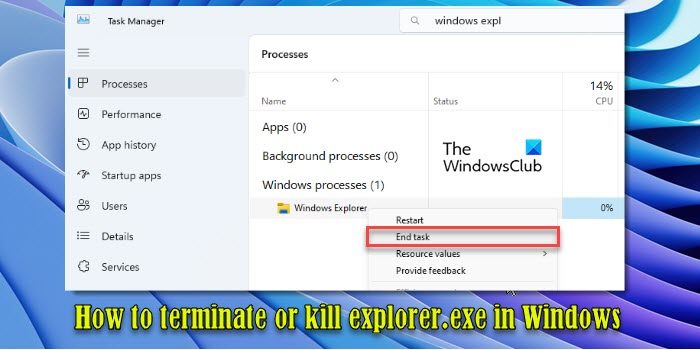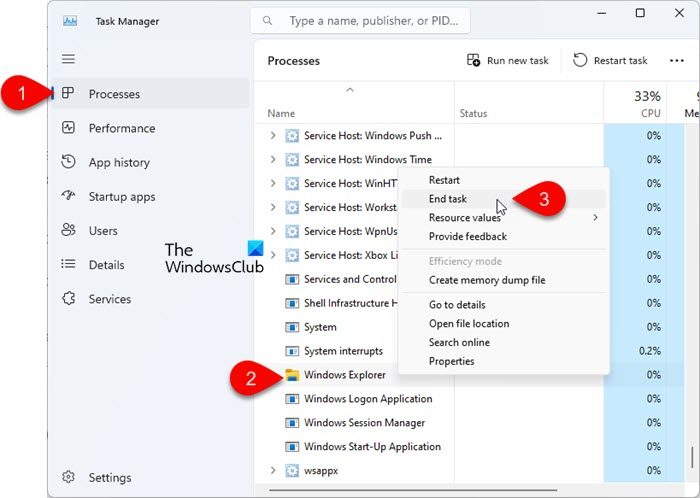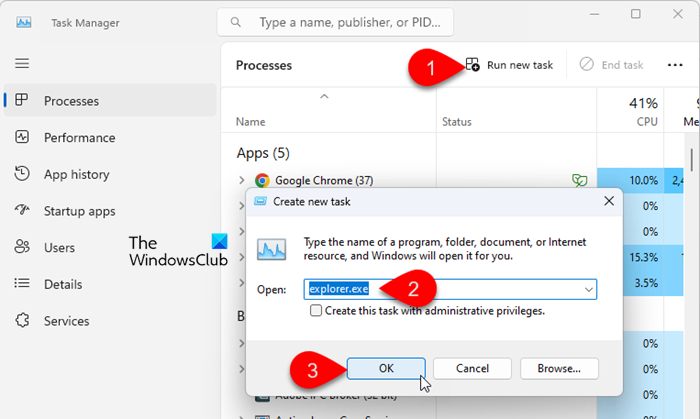This post explains how to terminate or kill explorer.exe on a Windows PC. There may be times when you may want to kill explorer.exe in Windows, maybe because your Windows explorer freezes frequently. The usual way of terminating the explorer process in Windows 11/10/8/7/Vista is through the Task Manager.

Kill explorer.exe in Windows
Windows 11, Windows 10 and Windows 8.1
To kill explorer.exe in Windows 11/10 follow these steps:
- Right-click anywhere in the taskbar area and select Task Manager.
- Select the Processes tab.
- Scroll down to the bottom of the list to locate Windows Explorer (explorer.exe).
- Right-click on it and select End task.

Terminating explorer.exe will close the File Explorer windows and the taskbar. If you do not restart it, you might lose access to your desktop and taskbar until you manually restart the process. Some applications might also behave unexpectedly, especially those that interact with the system tray or File Explorer.
To manually start explorer.exe, press Ctrl+Alt+Delete and then select Task Manager. Click the Run new task option in the top-right corner of the Task Manager. In the ‘Create new task’ dialog box, type explorer.exe and press Enter.

Windows 11/10 offers alternative ways to kill explorer.exe. Type ‘command’ in Windows Search bar and click Run as administrator next to the Command Prompt app. Type the following command in the Command prompt window and press Enter:
taskkill /f /im explorer.exe

To restart explorer.exe, type the following command and press Enter:
start explorer.exe
Windows 10/8 offers the context menu option to kill explorer (End task) as well as Restart Explorer in its Task Manager.

You can even exit explorer using the Taskbar context menu. You will see the option to Exit explorer.
TIP: Right-Click Restart Explorer adds Restart Explorer option to Context Menu.
Windows 7 and Windows Vista
Windows Vista & Windows 7 actually offers you a faster way to do it … in 3 clicks!

Click the Start button > Hold down Ctrl+Shift & right click on an empty area in the Start Menu > Click “Exit Explorer“.
To restart it, you will have to do so as usual through the Task Manager. Click Ctrl+Alt+Delete and select Start Task Manager or press Ctrl+Shift+Esc. Then launch explorer.exe manually.
By using the above methods, you can effectively terminate or kill the explorer.exe process on your Windows PC to resolve issues or perform necessary troubleshooting. However, always remember save any open work before killing the process to avoid losing unsaved changes or prevent data loss.
Read: Make File Explorer open to This PC instead of Quick Access in Windows.
What happens if explorer.exe is killed?
Killing the ‘explorer.exe’ process can affect several key components of the Windows user interface. When you kill explorer.exe, all open File Explorer windows on your Windows 11/10 PC will close immediately. You will no longer be able to view or access system tray icons and applications pinned to the taskbar. The desktop icons, taskbar, and Start menu will also disappear since explorer.exe manages these elements. While the system will still be operational, the UI elements managed by explorer.exe will not be available until you restart the process.
How to repair Windows Explorer in Windows 11?
If you’re experiencing issues with File Explorer in Windows 11, you can try several methods to repair it. Start by rebooting your computer and restarting the File Explorer. Next, run the System File Checker tool. Open Command Prompt as an administrator, type sfc /scannow in the Command Prompt window, and press Enter. Wait for the scan to complete and follow any on-screen instructions. If that doesn’t help, open File Explorer Options and click on Clear next to Clear File Explorer history. Also, try performing a clean boot, or resetting Windows to troubleshoot the issue.
In windows 8.1 you can also do it by pushigh ctrl+shift and right clicking on the task bar then it will give you an option to exit explorer
Hey, this one was new to me. Will update post. Thanks.